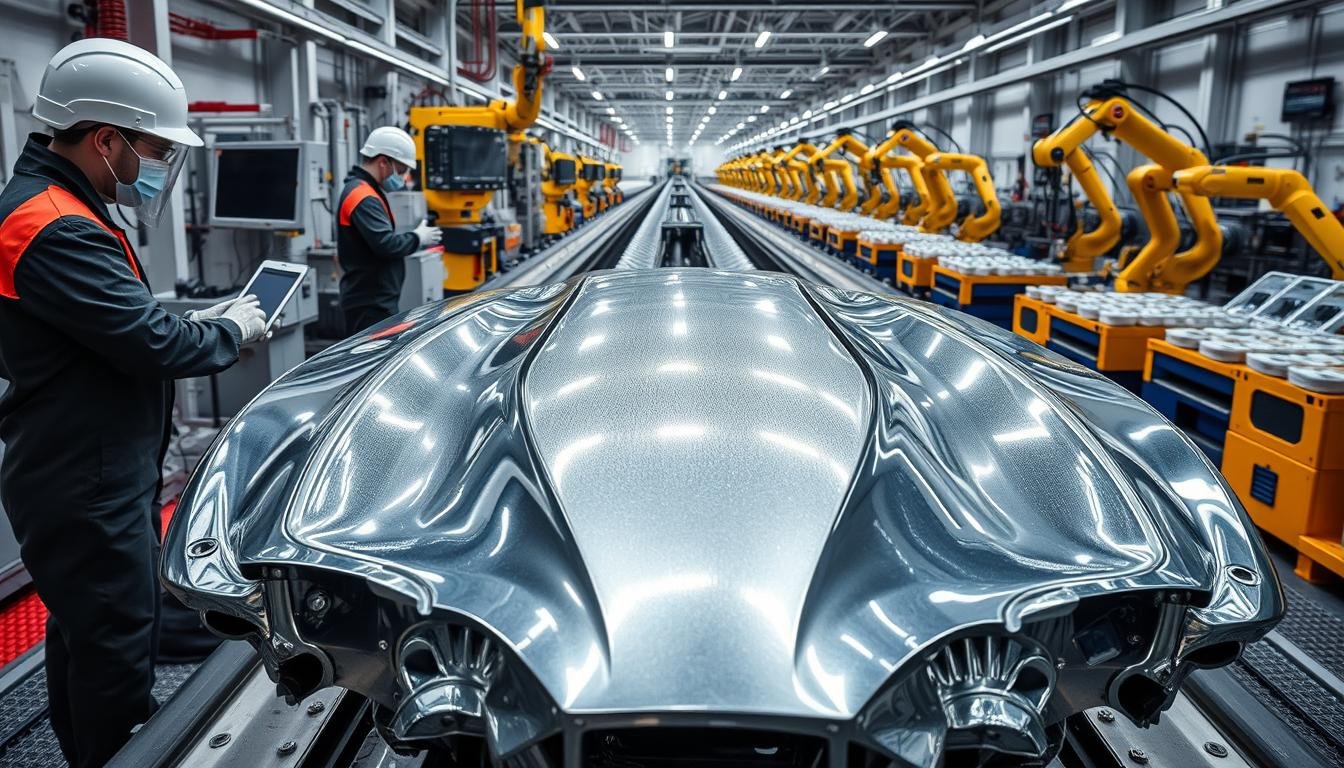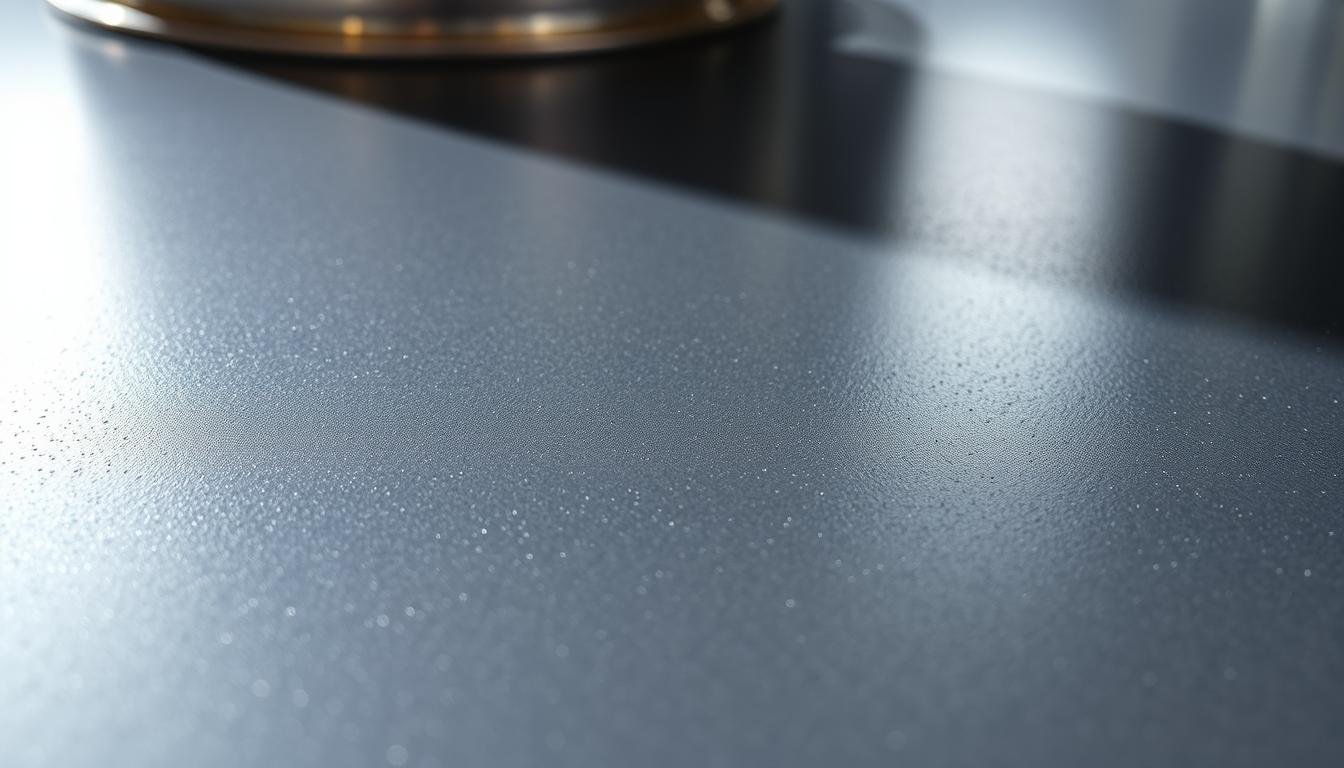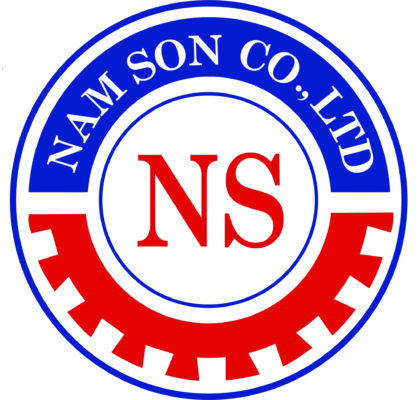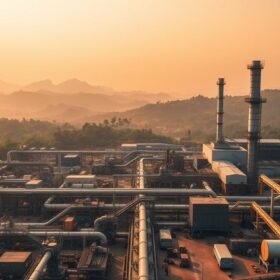Elevate Your Surfaces with High-Quality Surface Coatings
Surface coatings do more than just add a finish. They turn raw materials into strong, ready-to-use products. In today’s world, coating technology is key to protecting items from damage. It helps products last longer and look better.
Having paint lines in factories boosts efficiency. It lets companies save money and keep quality high. New coating tech offers special solutions for cars, electronics, and buildings. This makes products last longer and makes customers happier.
Key Takeaways
- Surface coatings protect products and improve their functional performance.
- Coating technology drives cost savings through in-house paint line integration.
- Industrial surface treatments enhance durability and market competitiveness.
- Modern coating systems streamline workflows and reduce outsourcing expenses.
- Quality paint lines are critical for maintaining production efficiency and product reliability.
Understanding Surface Coating Technologies in Modern Manufacturing

Surface coating is key to making products last longer and look better. It protects metal parts and makes things more attractive. Coating materials and surface finishing methods are driving new ideas in many fields.
Defining Surface Coating and Its Industrial Applications
Surface coating adds thin layers to surfaces to make them last longer, resist corrosion, or look better. Car makers use epoxy coatings for the underside of cars. The aerospace industry uses coating materials to protect against heat. These coatings are used in many areas, from machines to electronics and everyday items.
Evolution of Coating Technology in Manufacturing
Old coating methods were slow and not very precise. Now, we have electrostatic spray and robots for better results. Eco-friendly coatings are becoming popular in car making, cutting down emissions by up to 30%.
- Manual methods (1950s): Labor-intensive, high waste
- Automated lines (1990s): Increased throughput
- Smart systems (2020s): AI-driven quality checks
Key Players in the Surface Coating Industry
Big names like PPG Industries and Sherwin-Williams are leading in coating materials. Companies like Dürr and Fives are at the forefront of coating technology. Their work together has brought new coatings, like UV-curable ones for electronics.
| Coating Material | Primary Use | Leading Brands |
|---|---|---|
| Epoxy Resins | Metal corrosion protection | Henkel, 3M |
| Powder Coatings | Rugged industrial finishes | Axalta, BASF |
“In-house paint lines reduce lead times by 25% and ensure quality control.”
Factories using these new technologies save 15–20% by improving surface finishing processes. Choosing advanced coating systems helps meet ISO 12944 standards. This makes them more competitive globally.
The Critical Role of Paint Lines in Manufacturing Plants

Paint lines are key in modern manufacturing. They make applying protective coatings more efficient. A good paint line helps meet production goals, cutting downtime and increasing output.
How Paint Lines Integrate with Production Workflows
Integrating paint lines into production workflows needs careful planning. Important factors include:
- Material handling systems that work with assembly lines
- Adjustable line speeds that match production rates
- Curing technologies that fit coating applications
- Optimal placement in facility layouts to avoid bottlenecks
Automation Benefits in Modern Paint Line Systems
Automation changes paint line operations in many ways. It includes:
- Precision application of protective coatings with less human error
- 30%+ less material waste with robotic sprayers
- Consistent color and thickness across batches
- Safety features that reduce worker exposure to harmful fumes
Cost-Efficiency Analysis of In-House Paint Lines
| Factor | In-House Paint Lines | Outsourced Coating |
|---|---|---|
| Initial Investment | High equipment costs | Lower upfront expenses |
| Operational Costs | Lower long-term expenses | Rising per-unit pricing |
| Quality Control | Total process oversight | Dependent on vendor quality |
Studies show in-house paint lines cut costs by 25% over five years compared to outsourcing. This shows investing in paint lines can save money by reducing downtime and improving surface coating consistency.
Types of Surface Coatings for Industrial Applications

Manufacturers use many coating solutions to fit specific needs. The right industrial surface treatments help products last longer against the environment and wear. Here’s a look at how different coatings work for various uses:
| Coating Type | Key Features | Best Use Cases |
|---|---|---|
| Powder Coatings | Dry process, eco-friendly, high durability | Automotive parts, consumer appliances |
| Solvent-Based Coatings | Rich color options, flexible application | Wood substrates, decorative finishes |
| Electroplating | Metallic bond strength, corrosion resistance | Electrical components, marine equipment |
| Thermal Spray Coatings | Withstands extreme temperatures, abrasion | Heavy machinery, aerospace parts |
| Nano-Coatings | Self-cleaning, UV resistance | High-tech electronics, medical devices |
New corrosion resistant coating tech, like UV-curable systems, saves energy and boosts work speed. Companies with their own paint lines can try these coating solutions without needing outside help. For example, car parts makers use thermal spray, while appliance companies choose powder coatings for their cost savings.
Choosing the right coating helps meet both performance and green goals.
Benefits of Implementing Advanced Surface Coating Solutions
Modern manufacturing is all about innovation. It aims to improve product quality and make operations more efficient. Advanced protective coatings and coating solutions play a key role in achieving these goals. They give manufacturers a competitive edge in many areas.
Enhanced Product Durability and Longevity
Protective coatings protect products from environmental damage. For example, they prevent corrosion in harsh environments. This makes equipment last longer.
Abrasion-resistant surface finishing methods also help. They make sure machinery parts can handle heavy use. This reduces the need for frequent replacements and cuts down on downtime.
Aesthetic Advantages for Consumer-Facing Products
Consumer goods need to look good. The auto and electronics industries use coating solutions to create shiny, scratch-free surfaces. These finishes attract customers and help brands stand out, justifying higher prices.
Competitive Edge in the Manufacturing Marketplace
Companies that use advanced coatings can meet specific client needs. For example, they can create food-grade or non-stick surfaces for kitchenware. This opens up new markets and partnerships with global brands.
Regulatory Compliance and Environmental Considerations
Modern protective coatings are designed to reduce harmful emissions. They meet EPA standards. This helps factories avoid fines and attracts customers who care about the environment.
Having a paint line in-house ensures quality control. Companies like Caterpillar and Siemens use automated systems. This streamlines production, from research and development to final inspection. It maximizes the return on investment in surface treatment.
Selecting the Optimal Surface Coating for Custom Iron Parts
Choosing the right surface coating for custom iron parts is key. It affects how long they last and how much they cost. It’s important to pick materials that can handle the environment and fit with how they’re made.
An active paint line helps apply coatings like zinc-rich primers and epoxy systems. These are vital for keeping iron parts from rusting.
Corrosion-Resistant Options for Iron Components
- Zinc-rich primers protect well in salty environments.
- Epoxy coatings stick well in damp places.
- Hot-dip galvanizing keeps out industrial pollutants.
Specialized Coatings for High-Stress Applications
For parts in extreme conditions, we need special coatings:
- Ceramic coatings can handle up to 1,200°C in furnaces.
- Fluoropolymer systems shield against corrosive acids in chemical plants.
- Powder coatings offer strong protection against wear and tear.
Cost-Performance Framework
Manufacturers need to consider:
- Environmental exposure: Choose coatings that last as long as the part is used.
- Volume requirements: Making lots of parts is cheaper with powder coatings.
- Quality control: Having your own paint line means better control over coatings.
Choosing the best surface coating helps custom iron parts last longer and save money. Keeping your paint line in good shape ensures consistent quality.
Surface Preparation Techniques for Superior Coating Adhesion
Proper surface preparation is key for durable coatings. Without cleaning and conditioning, coatings may fail early. Treatments like abrasive blasting and chemical cleaning make surfaces ready for coatings.
- Abrasive blasting: Sand, steel grit, or aluminum oxide remove contaminants and create texture for mechanical bonding.
- Chemical cleaning: Solvents, alkaline washes, and acid etching dissolve oils, oxides, and residues from metal surfaces.
- Mechanical prep: Grinding, wire brushing, and sanding refine surfaces for precise coating compatibility.
- Advanced methods: Plasma or laser systems activate surfaces at a molecular level, boosting adhesion for high-tech materials.
Companies with industrial surface treatments in their paint lines have better quality control. Preparing surfaces right before coating stops contamination. This ensures strong adhesion.
Automated systems check grit size, chemical levels, and surface roughness. Regular checks lower defects and costs. Quality control includes profilometers and adhesion tests.
Boeing and car leaders follow these steps for long-lasting coatings. Skipping surface preparation can be expensive. But, the right methods can make products last 30-50% longer.
Vietnam Factories: Leveraging Global Expertise in Surface Treatments
Vietnam factories are becoming a key player in industrial surface treatments. They offer cost-effective solutions with advanced coating materials for the U.S. market. These facilities help U.S. manufacturers by taking care of specialized treatments, allowing them to focus on their core operations.
Quality Standards in Vietnamese Manufacturing Facilities
Top vietnam factory sites have ISO 9001 and ISO 14001 certifications. This ensures their coating materials meet U.S. standards. They use automated labs to check adhesion, corrosion resistance, and thickness. Now, over 70% of these facilities monitor data in real-time to keep up with global quality standards.
Cost Benefits of Vietnam-Based Coating Operations
- Labour costs are 35-45% lower than in U.S. facilities
- Energy-efficient coating systems save 20% on operational costs
- However, there’s a 15-20% premium for fast shipping to North America
Case Studies: Successful US-Vietnam Manufacturing Partnerships
| Industry | Outcome |
|---|---|
| Automotive | Reduced paint defect rates by 42% using advanced industrial surface treatments |
| Electronics | Met RoHS compliance for 98% of coating material batches in 2023 |
| Heavy Equipment | Cut lead times by 25% via joint R&D on corrosion-resistant coatings |
These partnerships show how vietnam factory collaborations boost global competitiveness. They let U.S. firms focus on innovation and design. By using coating materials expertise abroad, U.S. companies can improve their offerings.
Maintaining and Optimizing Your Paint Line for Maximum Efficiency
Keeping a paint line in top shape is key for quality and reliability. Regular care of coating technology stops protective coatings defects. Simple steps like cleaning nozzles weekly and oven checks every quarter keep things running right.
| Component | Task | Frequency |
|---|---|---|
| Spray Guns | Clean nozzles, check pressure | Weekly |
| Pumps | Lubricate seals | Monthly |
| Filters | Replace to avoid contamination | Bi-annually |
| Conveyor Systems | Align belts, check rollers | Bi-weekly |
| Curing Ovens | Calibrate temperature sensors | Quarterly |
Improving efficiency is another goal. Here are some ways to do it:
- Balance production speeds across stages
- Cut color change downtime with quick setups
- Reduce paint waste via precise application tech
- Lower energy use in curing zones
Training teams in surface finishing and upgrading control systems also helps. Adding smart sensors or robotic arms boosts automation. Skilled teams can fix problems and apply protective coatings best practices.
Being proactive with maintenance protects your investment in coating technology. An optimized paint line ensures high-quality finishes and keeps you competitive in manufacturing.
Conclusion: Transforming Your Manufacturing Capabilities Through Quality Surface Coating
Modern manufacturing relies on surface coating to make products last longer and look better. Using the latest coating solutions helps parts handle tough conditions and still look great. For U.S. makers, adding strong coating materials to their lines is key. It boosts how well things work and keeps products consistent, helping them quickly adapt to new trends.
Top manufacturers focus on getting surfaces ready right, choosing the right materials, and applying them carefully. Vietnam’s top spots show how to mix global standards with local skills for top-notch finishes. Companies without their own coating can start small, balancing costs with benefits like less downtime and a stronger brand.
New surface coating tech, like green polymers and smart tools, makes things even better. Going green with coating materials fits with the world’s shift towards being more eco-friendly. It’s important for makers to keep up with these changes to stay ahead.
Getting better at coating changes how things are made, making it a key part of innovation. By using the latest coating solutions, companies can lead in a world where lasting and green are key to success.



Leave a Reply
Want to join the discussion?Feel free to contribute!